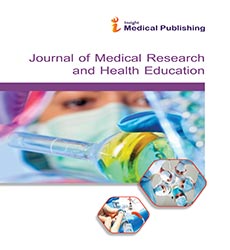A description of Congenital Heart Disease in Babies
Andraew Wangg*
Department of Clinical Pediatrics, University of Pennsylvania, US
- *Corresponding Author:
Received date: August 02, 2021; Accepted date: August 16, 2021; Published date: August 23, 2021
Citation: Andraew Wangg (2021) A Description of Congenital Heart Disease In Babies. J Med Res Health Educ Vol. 5 No. 4: 002
Commentary
A congenital heart defect happens when the structure os the heart is developed abnormally this happens mostly during pregnancy and when the baby is born. Congenital heart defects are the foremost common birth defects and therefore the leading cause of death in children. A baby's heart starts to develop at conception, but is totally formed by 8 weeks into the pregnancy. Congenital heart defects forms during the first 8 weeks of the baby's development.
The abnormalities can involve the walls of the heart, heart valves, and therefore the arteries and veins involving the heart, the abnormal formation of veins, arteries and valves of the heart will disrupt the regular flow of blood through the heart. The blood flow may get low, enter into a different direction or to the incorrect chamber, or may be blocked completely.
The causes of CHDs among most babies are mostly not well known. Some babies have heart defects due to genetics or the defective gene may run in the families. CHDs are also thought to be caused by a mixture of genes and other factors, like mutations within the environment. Smoking and excessive alcohol consumption during pregnancy and use of medicines within the trimester of pregnancy is risk factors for congenital heart condition in children, and therefore the risk increases if parent or sibling features a congenital heart defect.
Signs and symptoms for CHDs depend upon the sort and severity of the actual defect. Some defects may show few or no signs or symptoms. Blue tinted nails or lips, Fast or troubled breathing, Tiredness when feeding, Sleepiness, Rapid heartbeat, Swelling round the eyes and swelling of legs and tummy.
Some CHDs could also be diagnosed during pregnancy using foetal echocardiogram, which creates ultrasound pictures of the heart of the foetus. However, some CHDs aren't detected until after birth or later in life, during childhood or adulthood. If a healthcare provider suspects a CHD could also be present, the baby can get several tests such as a Pulse Oximetry Screening, Hyperoxia Test, Electrocardiogram (ECG), Chest X Ray, Two Dimensional Echocardiography, and Additional Imaging Modalities. to verify the diagnosis. Children with congenital heart condition are best evaluated, when possible, in paediatric cardiology centres and by echocardiographic centres certified in congenital heart condition.
Several medications are prescribed based on the severity of this disease and surgery is required for serious cases to repair heart valves or heart transplantation as in endocarditis. After foetal echocardiogram makes a diagnosis of CHD, specialized delivery room planning is required for prompt management.
At birth, if a CHD is suspected, appropriate stabilization, oxygen therapy, infusion of prostaglandin E1 is done. Prostaglandin E1 is beneficial for ductal dependent lesions as bridging therapy for further interventions or cardiac surgery. Approximately 25% of babies born with a CHD will need operation or interventions to survive. After the cardiac surgery is performed, the baby is kept under intensive care and every postoperative problem be identified and treated, for instance, heart rhythm disorders, respiratory failure, coronary failure, seizures, haemolysis, infections, post pericardiotomy syndrome, thromboembolism and stroke, kidney failure.
Open Access Journals
- Aquaculture & Veterinary Science
- Chemistry & Chemical Sciences
- Clinical Sciences
- Engineering
- General Science
- Genetics & Molecular Biology
- Health Care & Nursing
- Immunology & Microbiology
- Materials Science
- Mathematics & Physics
- Medical Sciences
- Neurology & Psychiatry
- Oncology & Cancer Science
- Pharmaceutical Sciences
